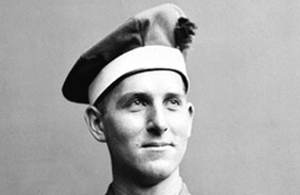WW1 Canadian VC recipient Thomas Fasti Dinesen
The story of Canadian First World War Victoria Cross recipient Thomas Fasti Dinesen.

Thomas Fasti Dinesen [Credit: National Defence Canada]
70 men from Canada received the Victoria Cross, Britain’s highest award for gallantry, during the First World War. As part of the Centenary Commemorations the people of the United Kingdom marked their gratitude to those courageous men by presenting a bronze memorial plaque to their home country engraved with their names. The plaque is now displayed at the British High Commission Ottawa. This archive tells their stories.
Name: Thomas Fasti Dinesen
DOB: 9 August 1892
Place of Birth: Rungsted, Denmark
Date of Action: 12 August 1918
Place of Action: Parvillers, France
Rank: Private
Regiment: 42nd Infantry Battalion, Canadian Infantry Expedition
Thomas Fasti Dinesen was born in Rungsted, Denmark on 9 August 1892. During the First World War, he tried unsuccessfully to join the French, British and American armies. Eventually, he was able to enlist in the Royal Highlanders of Canada.
Private Dinesen was awarded his Victoria Cross for his bravery on 12 August 1918 while serving with the 42nd Infantry Brigade. It was at the start of the Battle of Amiens, that his actions helped to capture over a mile of heavily-defended German trenches over a 10 hour period. His citation explains further:
For most conspicuous and continuous bravery displayed during ten hours of hand-to-hand fighting, which resulted in the capture of over a mile of strongly garrisoned and stubbornly defended enemy trenches. Five times in succession he rushed forward alone, and single-handed put hostile machine guns out of action, accounting for twelve of the enemy with bomb and bayonet. His sustained valour and resourcefulness inspired his comrades at a very critical stage of the action, and were an example to all.
He was awarded the Croix de Guerre by the French Government, and commissioned as an officer. After the war Dinesen moved to British East Africa to help his sister, the writer Karen Blixen manage her farm. He later moved back to Denmark, and became a writer. He died in Denmark in 1979.